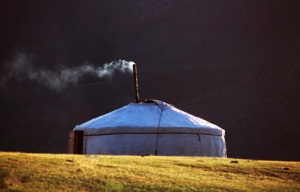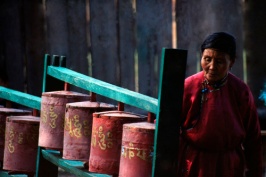Reflections on Mongolia (In summer)

Not the most attractive of cities, Ulan Bator (UB), the capital of Mongolia, is not without its charms. Perhaps not a city to spend more than a few days in, but the city’s sights can be enjoyed as an example of a capital totally alien to the rest of its country. In UB you can eat in international restaurants where there is more than boiled mutton on the menu and drink in cafes where you can get Austrian coffee instead of fermented mares’ milk.
While battling the choking dust and piles of rubble, avoiding the few abnoxious alcoholics, looking further than the soviet-style buildings and surviving the life-threatening traffic chaos – the visitor can be treated to the following: an array of fine museums, spectacular concerts of traditional music and dance, extravagant, ancient palaces showing an opulence and lifestyle of past centuries and tranquil Buddhist monasteries.

A good introduction to Mongolian life is the Black Market, otherwise known as the Thieves Market (for a reason), the massive central market where locals shop for most things! All your senses will be heightened as you wander through this vast array of goods amid a population still dressed in traditional clothes …. Rows of torturous wooden saddles, assorted horse paraphernalia, genuine antiques, vivid orange ‘ger’ furniture alongside fifties style furniture for the modern UB apartment. Endless rows of boots – some for riding, snow walking and some for dancing with turned up toes and elaborate embroidery. Men poring over piles of hardware, women feeling shimmering silks and satins while nearby endless supplies of dissected sheep vie for space with piles of onions, potatos and summer fruits.

However, the true attraction of this wild, free and almost fenceless country is evident as soon as you can organise an essential four wheel drive vehicle (or perhaps a horse) to explore an almost road-less landscape. The experience is a wildness and space with flowering meadows, tree-less steppe and larch forests. Beautiful fresh and saltwater lakes abound with birdlife and fresh water rivers are clean and full of fish.
The humbling vastness of a land populated by magnificent horses, woolly yaks, herds of goats, sheep and untethered camels compares only with the freely given hospitality of the nomadic peoples. They live a lifestyle of past generations whose rules of life dictate helping others and a sharing of everything. As a visitor you will be welcomed into their gers (round felt tents), offered milk alcohol or airag – the ubiquitous fermented mares’ milk, creamy yak cheeses and bowls of freshly gathered wild berries. You will be expected to share what you have and in return you may wish to re-evaluate the modern lifestyle which you have temporarily escaped. Warming yourself by a dung fuelled fire, contributing your stashed vodka or joining families under a sky crammed with a million stars while they sing songs about their lives. Curious children will peer at you from behind long dels – the traditional clothing worn by both parents and soon you will receive shy smiles from very grubby, small faces. If you stay long enough you may be invited to watch the milking of the mares and yaks by women and girls who sit beside them on small stools, collecting the valuable gift from their beloved animals – from which their very existence depends. …


My partner and I stumbled over here from a different web page and thought I might as well check things out.
I like what I see so now i am following you. Look forward to going over your
web page yet again.
LikeLike
I’m impressed, I have to admit. Seldom do I come across a
blog that’s both equally educative and interesting, and let me
tell you, you have hit the nail on the head.
The issue is something which not enough men and women are speaking intelligently about.
Now i’m very happy I found this in my search for something relating to
this.
LikeLike
I think this is among the most important information for me.
And i’m glad reading your article. But should remark on some general things, The website style is great, the articles is really great : D.
Good job, cheers
LikeLike
I’m now not certain the place you are getting your info, however great topic.
I needs to spend some time learning much more or understanding more.
Thank you for excellent information I used to be in search of this info for my mission.
LikeLike
What’s up mates, good article and fastidious arguments commented at
this place, I am in fact enjoying by these.
LikeLike
Great delivery. Great arguments. Keep up the good effort.
LikeLike
Thanks for ones marvelous posting! I definitely enjoyed reading
it, you will be a great author.I will be sure to bookmark your blog and definitely will come back in the foreseeable future.
I want to encourage that you continue your great work, have a nice holiday
weekend!
LikeLike
Hi there! I’m at work browsing your blog from my new apple iphone!
Just wanted to say I love reading through your blog and
look forward to all your posts! Carry on the outstanding work!
LikeLike
Very good info. Lucky me I came across your blog by accident
(stumbleupon). I’ve bookmarked it for later!
LikeLike
After looking at a number of the articles on your website,
I seriously like your technique of blogging. I bookmarked
it to my bookmark website list and will be checking back in the near future.
Please visit my web site as well and let me know how you feel.
LikeLike
I’m truly enjoying the design and layout of
your site. It’s a very easy on the eyes which makes it much more pleasant
for me to come here and visit more often. Did
you hire out a designer to create your theme? Fantastic work!
LikeLike
Every weekend i used to pay a visit this website,
as i want enjoyment, for the reason that this this web site conations truly good funny data too.
LikeLike
I really like what you guys tend to be up too.
This sort of clever work and reporting! Keep up the wonderful works guys I’ve incorporated you guys to my personal blogroll.
LikeLike
not that much of a internet reader to be honest but your blogs really nice, keep it up! I’ll go ahead and bookmark your website to come back later. Many thanks
LikeLike
Hello, you post interesting articles on your blog, you
deserve much more visitors, just search in google for – augo’s
tube traffic
LikeLike
Good day! This is my first visit to your blog! We are a group of volunteers and starting a new project in a community in the same niche. Your blog provided us valuable information to work on. You have done a outstanding job!
LikeLike
I like what you guys are up too. This type of clever work and coverage! Keep up the superb works guys I’ve you guys to my blogroll.
LikeLike
I’m usually overly critical as it pertains to writing. However, your sources are great.
LikeLike